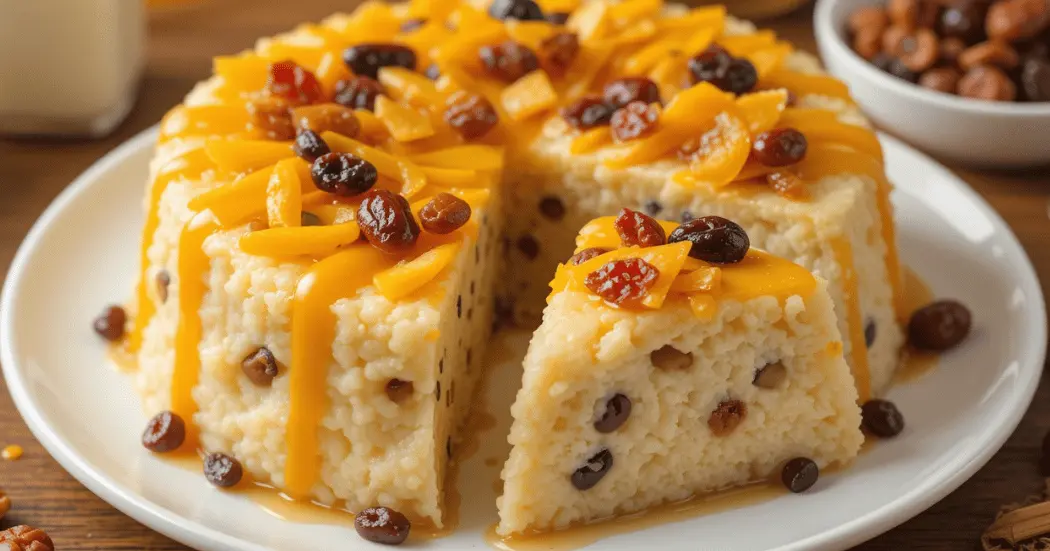Ba Bao Fan, also known as Eight-Treasure Rice, is more than just a dessert—it’s a dish steeped in celebration, culture, and symbolism. Made with sticky glutinous rice and adorned with a rainbow of dried fruits, nuts, and sweet fillings like red bean paste, this dish has stood the test of time, making appearances at Lunar New Year feasts, weddings, and family reunions.
In this guide, we’ll walk you through everything you need to know about crafting a traditional Ba Bao Fan recipe at home—from selecting the right ingredients and preparing the rice to mastering the steaming process. We’ll also dive into cultural roots, modern twists, health tips, and answer some burning questions from curious cooks.
So grab your bamboo steamer and let’s dive into the delicious world of Eight-Treasure Rice!
Table of Contents
Introduction to Traditional Ba Bao Fan
What is Ba Bao Fan? (八宝饭)
Let’s start with the basics—Ba Bao Fan, literally translated as “Eight-Treasure Rice”, is a steamed sticky rice pudding that’s a classic in Chinese culinary tradition. Made with glutinous rice and topped (or filled) with eight distinct ingredients—usually a combo of nuts, seeds, and dried fruits—this sweet dish is more than just a treat. Each ingredient represents luck, prosperity, and happiness.
And despite its humble, homey appearance, this dish boasts centuries of history and artistry. You’ll often find it gracing tables during Lunar New Year, signaling sweetness and fortune in the year to come.
Cultural Significance During Festive Occasions
Why eight treasures? Well, the number eight (八, ba) is considered the luckiest number in Chinese culture, symbolizing wealth and success. That’s why this dessert is the centerpiece at big events—from weddings to New Year banquets. It’s not just food—it’s a wish for abundance.
Each “treasure” has meaning too. For instance, lotus seeds often represent fertility, while dates bring luck. Combine that with the comforting texture of sticky rice and the fragrance of steamed red bean paste, and you’ve got a dish that feeds both belly and soul.
Why It’s Called “Eight-Treasure” Rice
Now, don’t get too hung up on the number—sometimes there are more than eight ingredients! But traditionally, eight different mix-ins are chosen to represent blessings. Think: red dates, longans, raisins, peanuts, lotus seeds, walnuts, candied cherries, and melon seeds.
The beauty of a traditional ba bao fan recipe lies in its versatility—you can adjust the ingredients while keeping the heart of the dish intact. Whether you’re preserving grandma’s version or creating your own festive twist, this dessert always feels like a celebration.
Essential Ingredients of a Traditional Ba Bao Fan Recipe
Sticky Glutinous Rice & Purple Rice: The Base
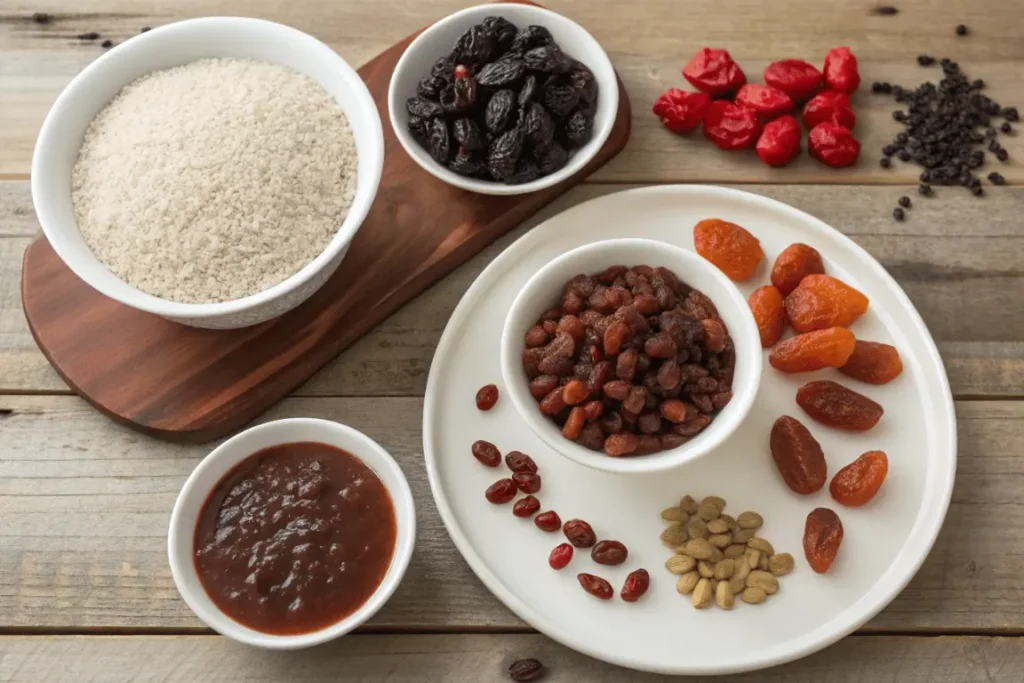
The heart of any traditional Ba Bao Fan recipe is the rice. But not just any rice—glutinous rice, also called sweet rice, is what gives this dish its chewy, sticky texture. It’s what makes each bite soft and satisfying. If you’ve got access to purple or black sticky rice, don’t hesitate to mix it in. Not only does it boost the flavor, but it adds a lovely hint of color and nutty depth.
Before cooking, always soak the rice for at least 4–6 hours. Why? Well, this step ensures even cooking and that perfect, slightly springy texture. You can steam it plain or add a bit of sugar and coconut milk for a richer base.
The Eight Treasures: Fruits, Nuts, Seeds & Symbolism
Now comes the fun part—the treasures! A traditional Ba Bao Fan recipe typically calls for a mix of eight symbolic ingredients. These include red dates, lotus seeds, dried longan, raisins, walnuts, peanuts, candied melon, and goji berries. Feel free to sub in what you’ve got, but stick to a variety of textures and colors.
Each ingredient adds more than taste—it adds meaning. Red dates symbolize fortune, lotus seeds wish fertility, and longans? They’re said to bring good luck. Together, they don’t just look stunning—they create a tapestry of flavor and tradition.
So, whether you’re honoring ancestral roots or just craving something sweet and sticky, these treasures are what transform rice into celebration.
Step-by-Step Traditional Ba Bao Fan Recipe
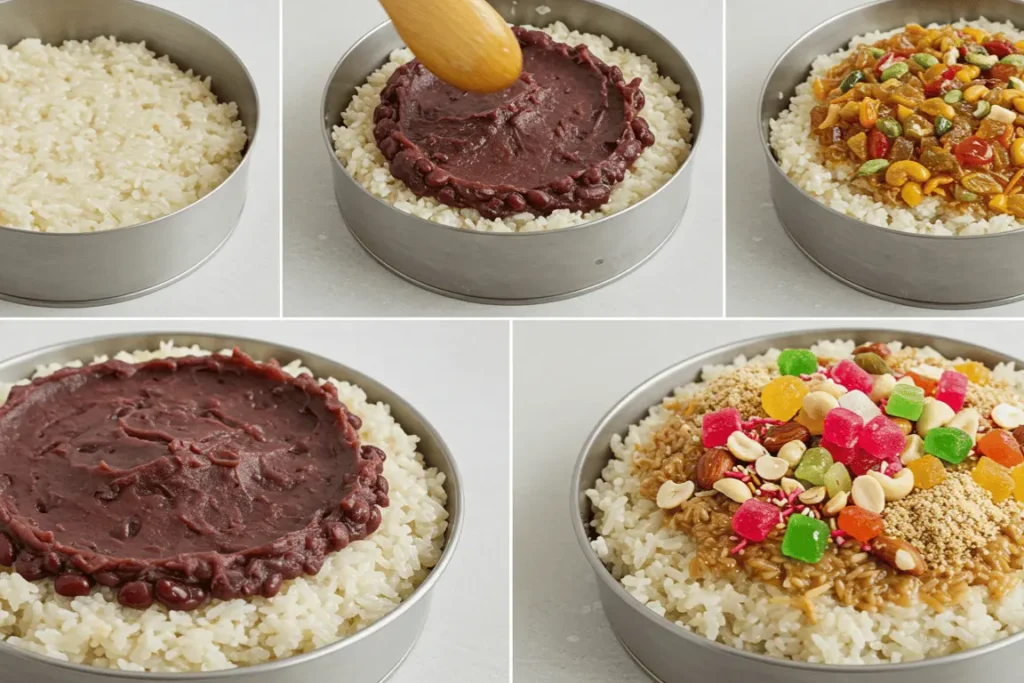
Preparation of Glutinous Rice and Red Bean Paste
Alright, time to roll up those sleeves! First things first—start by soaking your glutinous rice overnight. This step is crucial. Without it, your rice might steam unevenly or turn out too tough. Once soaked, drain the rice and prepare your steamer.
While the rice is steaming, get your red bean paste ready. You can use store-bought paste, but homemade is miles better. Simply cook adzuki beans with a touch of sugar until soft, then mash into a smooth paste. It’s sweet, earthy, and gives the dish its signature center.
Once your rice is done—fluffy and slightly sticky—set it aside to cool for easier handling.
Layering the Eight Treasures for Visual Appeal
Now comes the artistic part. In a heat-safe bowl or mold, arrange your “eight treasures” at the bottom. Think of this as your decorative crown. Use bright-colored items like goji berries, candied cherries, and melon for that wow factor.
Next, press a layer of sticky rice gently over the fruits. Spread a layer of red bean paste in the center, then top it off with the rest of the rice. Be sure to press everything down gently but firmly so it holds its shape after steaming.
Finally, steam the assembled dish for about 30–40 minutes. When it’s done, let it cool slightly. Then comes the big reveal—flip it onto a plate like a cake and marvel at your mosaic of colorful treasures!
There you have it: a complete traditional Ba Bao Fan recipe that’s festive, symbolic, and full of flavor. Whether you’re making it for Lunar New Year or just to warm up a winter day, this dish always feels special.
Variations and Regional Twists on Ba Bao Fan
Cantonese vs. Shanghai Styles
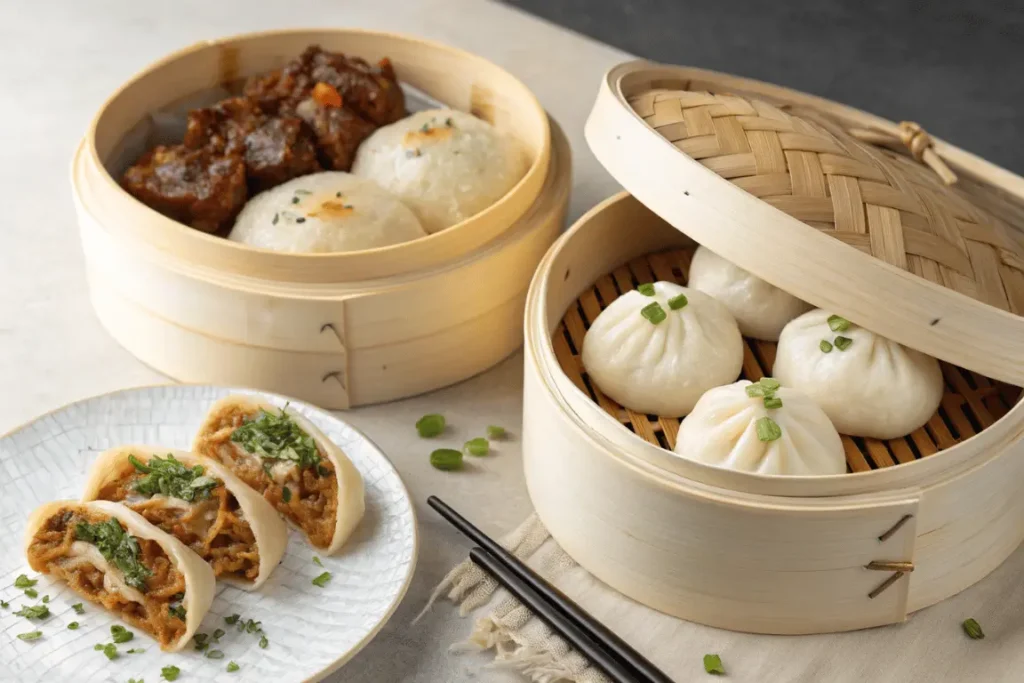
If you thought there was only one way to make Ba Bao Fan, think again! While the traditional Ba Bao Fan recipe stays true to its sweet roots, regional flavors have added unique twists over the years. In Cantonese cuisine, for instance, the dish tends to be lighter, with floral notes like osmanthus syrup. You’ll often find a glossier finish and a milder sweetness.
In contrast, Shanghai-style Ba Bao Fan leans richer. It’s dense, filled with lard-infused red bean paste, and boasts a hearty mix of nuts and candied fruits. This version often includes ingredients like candied winter melon or green peas for extra texture.
Alternative Fillings & Sweeteners
Don’t be afraid to experiment. While red bean paste is a staple in most traditional recipes, you can substitute with lotus seed paste or even sweet black sesame paste for a deeper flavor.
Trying to cut down on refined sugar? Use honey or dates as natural sweeteners. Some home cooks even incorporate coconut cream for a tropical spin. That’s the beauty of this dish—it’s flexible, festive, and always open to a little creativity.
Tips for Perfect Ba Bao Fan Every Time
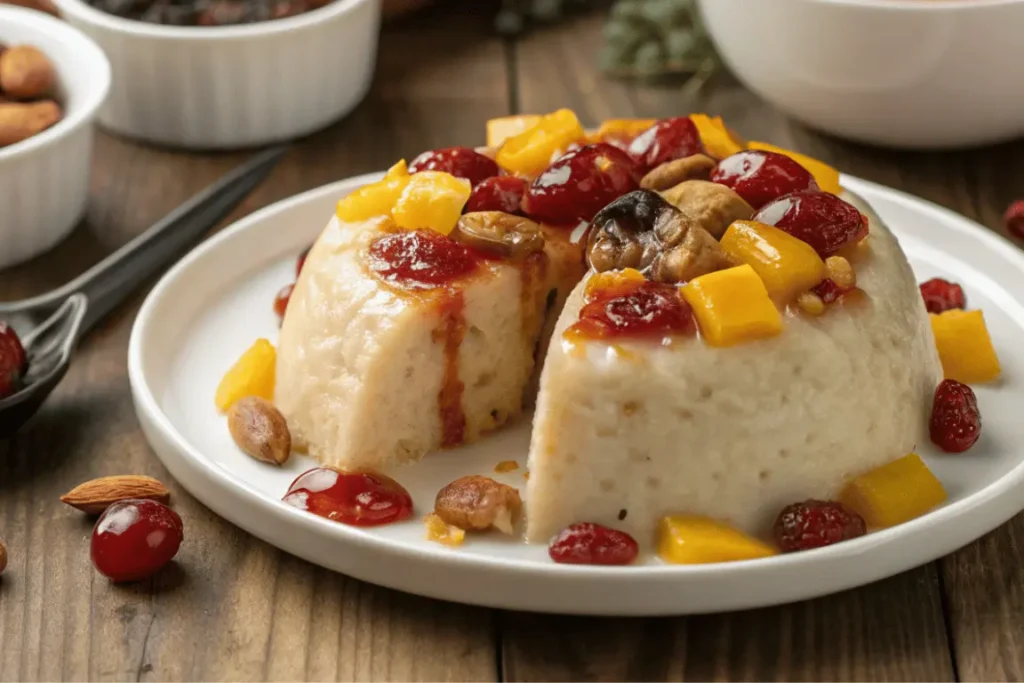
Soaking Times, Rice Texture, and Equipment Choices
Nailing a traditional Ba Bao Fan recipe starts with prep. Always soak your glutinous rice for at least 4 hours, ideally overnight. This softens the grains, helping them steam evenly without becoming mushy. Want that ideal chewy bite? Steam the rice instead of boiling—it keeps the grains separate yet sticky.
For steaming, bamboo baskets are traditional and infuse a light, woody aroma into the dish. But metal or electric steamers work just as well. Just make sure to line your steamer with parchment or banana leaves to avoid sticking.
Avoiding Common Mistakes
Even experienced cooks run into trouble with this dessert. Too much water during steaming can make your rice soggy. On the flip side, rushing the steaming process often leads to undercooked centers.
Another tip? Don’t overload your “treasures.” While it’s tempting to pack the dish with goodies, keeping a balanced ratio ensures you taste the rice, paste, and toppings in every bite. And always let the dish rest for 5–10 minutes before unmolding—it helps everything hold together beautifully.
Nutritional Insight & Healthier Adaptations
Is Ba Bao Fan Healthy? Nutrient Breakdown
While Ba Bao Fan is rich in tradition, it’s also pretty rich in calories. Thanks to its combo of sticky rice, sugary paste, and candied fruits, one serving can pack a hefty punch. But don’t let that scare you off! A traditional Ba Bao Fan recipe offers more than just sweetness.
Glutinous rice provides complex carbs, while toppings like walnuts and lotus seeds bring in healthy fats and a touch of protein. Raisins, dates, and goji berries add fiber and natural sugars. So yes, it’s indulgent—but it’s not all bad.
Lower Sugar & Vegan Alternatives
Looking to lighten things up? You’re in luck. Swap in natural sweeteners like honey, maple syrup, or mashed dates. You can also use unsweetened red bean paste or cut the sugar in half.
Going plant-based? Good news: most versions of the traditional ba bao fan recipe are naturally vegan. Just skip butter (if used) and stick to plant-friendly fillings.
FAQs – People Also Ask
Q: Can I make Ba Bao Fan without a steamer?
Absolutely! If you don’t have a steamer, you can use a heatproof bowl set inside a large pot with a rack and lid. Just be sure the bowl doesn’t touch the water, and steam gently for 40–45 minutes. It may take a bit more monitoring, but it works just fine.
Q: Why is it called Eight-Treasure Rice?
Great question. The name comes from the eight symbolic toppings used in a traditional Ba Bao Fan recipe. In Chinese culture, the number eight brings good luck. Each ingredient—like red dates or peanuts—represents a blessing, such as happiness or prosperity.
Q: How long can I store Ba Bao Fan?
Once cooked, you can store Ba Bao Fan in the fridge for up to 3 days. To reheat, steam it again or microwave it with a damp cloth on top to restore moisture.
Q: Is it served hot or cold?
Traditionally, it’s served warm—steamed fresh or reheated. But some folks enjoy it chilled, especially during summer festivals.
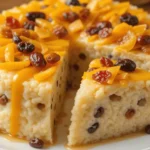
Ba Bao Fan Recipe
- Total Time: 7 hours 10 minutes
- Yield: 6 servings 1x
- Diet: Vegan
Description
A festive and symbolic Chinese dessert made with sticky rice, red bean paste, and a vibrant medley of dried fruits and nuts—perfect for Lunar New Year and special celebrations.
Ingredients
- 2 cups glutinous rice
- 1/2 cup purple sticky rice (optional)
- 1 cup red bean paste
- 1/4 cup red dates
- 1/4 cup lotus seeds
- 1/4 cup dried longan
- 1/4 cup raisins
- 1/4 cup walnuts
- 1/4 cup peanuts
- 1/4 cup candied melon
- 1/4 cup goji berries
- 2 tbsp sugar (optional)
- 1/4 cup coconut milk (optional)
Instructions
- Soak glutinous rice (and purple rice if using) in water for 4–6 hours or overnight. Drain before use.
- Steam the rice for 30–40 minutes until cooked through and sticky.
- Prepare red bean paste by cooking adzuki beans with sugar until soft, then mashing into a smooth paste (or use store-bought).
- In a heatproof bowl or mold, arrange a mix of eight treasures decoratively at the bottom.
- Press half of the steamed rice on top of the treasures.
- Spread red bean paste evenly over the rice layer.
- Top with the remaining rice and press down firmly.
- Steam the assembled dish for another 30–40 minutes.
- Let cool slightly, then invert onto a serving plate and serve warm.
Notes
For best results, always soak the rice beforehand and steam rather than boil for the ideal chewy texture. Balance the toppings for flavor and symbolism.
- Prep Time: 6 hours (includes soaking)
- Cook Time: 70 minutes
- Category: Dessert
- Method: Steaming
- Cuisine: Chinese
Nutrition
- Serving Size: 1 serving
- Calories: 350
- Sugar: 18g
- Sodium: 30mg
- Fat: 6g
- Saturated Fat: 1g
- Unsaturated Fat: 4g
- Trans Fat: 0g
- Carbohydrates: 68g
- Fiber: 4g
- Protein: 7g
- Cholesterol: 0mg
Conclusion
There you have it—everything you need to know to master the traditional Ba Bao Fan recipe. From its rich cultural roots to its sweet, sticky layers of flavor, this festive dessert brings both meaning and joy to the table. Whether you’re preparing it for Lunar New Year or simply craving something comforting and symbolic, Ba Bao Fan is a timeless treat that never goes out of style. So gather your eight treasures, steam with care, and enjoy a dish that’s as beautiful to look at as it is to eat.
For more delicious recipes, check out our other guides and sweet creations on eppicrecipes.com.

